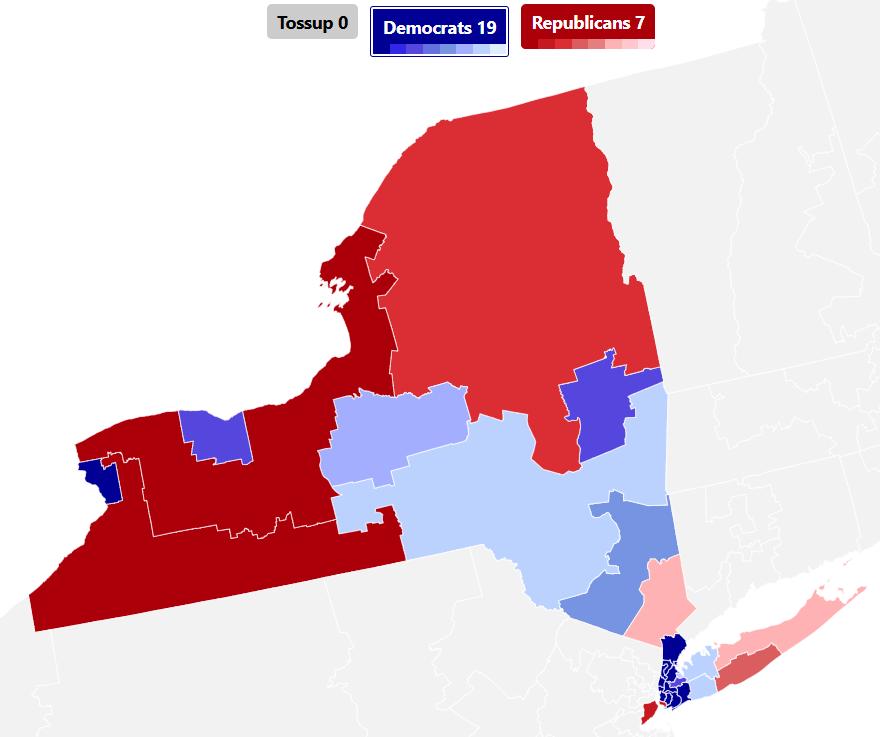Where To Find Us













By Matt Meduri
The only prize at the federal level for the 2026 midterm elections is control of the U.S. House of Representatives. Republicans clawed back a thin majority in 2022 and retained their majority in 2024 despite losing one (net) seat.
Their majority is further complicated by early resignations and retirements of key moderates in swing districts likely to define the next session of Congress. Republicans currently hold a tenuous 219-seat quorum.
Continued on page 4
For the past decade, sixteen-year-old Delilah Gallo, a junior at Smithtown High School West, has competed in the sport of baton twirling. Twirling combines dance, gymnastics and coordination, using a baton to create routines synchronized with music and choreography.
“Practicing and performing are my favorite things,” Delilah told us. “I love to show my hard work and talent on the competition floor. I also love sharing my passion of twirling with the younger girls that I coach and watch them grow and become better.”




This month, Delilah will travel to Italy with her partner, Delaney Higgins, to represent the United States at the International Baton Twirling Federation (IBTF) competition.
“I’m looking forward to representing Team USA and competing against the best athletes in the world,” she said.
This isn’t Delilah’s first major competition. In 2022, she was the youngest member of Team USA at just twelve years old. For the past four years, she has represented the United States in international competitions, traveling to Italy, Sweden and England.
This year, Delilah will compete in the categories of Artistic Twirl and Artistic Twirl Pairs with Higgins.
Mother's Day Brunch at Long Island Aquarium
Port Jefferson Summer Farmers Market at Harborfront Park
May 11, 10:00 AM, 12:00 PM, 2:00 PM, 4:00 PM
Market on Main Street at Aroogas
August 10, 12:00 PM to 5:00 PM
Bird and Breakfast at Connetquot State Park
Every Saturday and Sunday, May 18-November 28
May 11, 8:00 AM to 11 :00 PM
Oyster Jamboree at Smith Point County Beach
Fleece and Fiber Festival at Hallockville Museum Farm
9:00 AM to 2:00 PM
May 17, 10:00 AM to 4:00 PM
August 16, 1:00 PM to 6:00 PM
Islip Farmers Market at Town Hall Every Sunday, June 7-November 22, 7:00 AM to 12:00 PM
Nesconset Spring Fling May 18, 10:00 AM to 5:00 PM
Back to School Bash at The Shoppes at East Wind
Jones Beach Air Show May 24-25, 10:00 to 4:00 PM
August 16, 11:00 AM to 5:00 PM








PUBLISHER
Raheem Soto
EDITOR-IN-CHIEF
Matt Meduri
STAFF REPORTERS Cait Crudden
ART PRODUCTION
MANAGER
Sergio A. Fabbri
GRAPHIC DESIGN Colin Herr
CONTRIBUTORS
PJ Balzer
Ashley Pavlakis
MANAGER
Tim Walz
DELIVERY PERSONNEL
PJ Balzer
Joe Cuminale




Madison Warren
OFFICE MANAGER & ACCOUNTS
RECEIVABLE
Kim Revere
PROOFREADER
Giavanna Rudilosso
SOCIAL MEDIA
Madison Warren
Published by Messenger Papers, Inc.
Beginning Monday, August 4, motorists and pedestrians along Edgewood Avenue can look forward to a smoother, safer, and more attractive commute. Thanks to funding from a State HUD Grant, the Town of Smithtown Highway Department has officially broken ground on a fullscale reconstruction project that will transform the Edgewood corridor from Jericho Turnpike (Route 25A) to North Country Road (Route 25). Work is expected to take approximately six weeks to complete.
August 7, 2025

“Edgewood Avenue is not only a heavily traveled road for motorists—it’s also a daily route for schoolchildren and pedestrians who deserve a safe, well-designed streetscape,” said Supervisor Ed Wehrheim (R-Kings Park). “These upgrades will give drivers a safer roadway, improve walkability for residents, and give parents peace of mind as their children walk to and from school. This long-awaited project is possible thanks to our fantastic grant team, our Highway Department led by Superintendent Robert Murphy, and the expertise of our Planning, Engineering, and Environmental staff. Together we are delivering vital improvements like the Edgewood Reconstruction project, without adding to the taxpayer burden.”
The highly anticipated upgrades will include brand-new concrete curbs,
sidewalks, and aprons, ensuring safer pedestrian access and improved drainage. Once the concrete work is complete, the roadway will be fully repaved and striped, giving Edgewood Avenue a clean, fresh look while enhancing traffic safety.
“This is far more than a standard paving job—it’s a full streetscape enhancement designed to improve safety, accessibility, and the overall experience for everyone who uses Edgewood Avenue,” said Highway Superintendent Robert Murphy (R-St. James). “This stretch is a daily route for many children walking to and from school, as well as residents who treasure the peaceful tree canopy and nearby vineyard as a place to walk their pets or enjoy some fresh air and exercise. These improvements will make those walks safer and more enjoyable, while creating a roadway that is both functional and visually appealing for all who travel it.”
Work is scheduled to take approximately six weeks, weather permitting, with crews working diligently to minimize disruption to residents and businesses along the route.
This project underscores the Town’s ongoing commitment to investing in critical infrastructure, enhancing pedestrian safety, and maintaining the charm and functionality of Smithtown’s neighborhoods.
Meet Dufus & Mooney — the feline equivalent of an old married couple who’ve seen a lot together and still choose to snuggle on the same couch. These sweet, affectionate two-and-a-half-year-old brothers were adopted for a senior citizen who, sadly, could no longer care for them. Now, they’re back in search of their next (and hopefully forever) chapter.
Let’s be honest — these boys are in need of some TLC, a loving home… and, well, a diet.
Both Dufus and Mooney are accustomed to the good life: quiet days, soft laps, and the kind of love that comes with a calm, peaceful home. They’d thrive best with older kids and cat-savvy humans who understand the art of a slow approach and a steady schedule.

Dufus sports a badge of honor — an old eye injury that’s being treated on our watch. He doesn’t let it slow him down one bit, and Mooney is right by his side, ready for head scratches and attention from anyone willing to dole it out.
If you’re looking for a pair of low-drama, highaffection companions who will fill your home with warmth, whiskers, and occasional judgment about your snack choices, Dufus & Mooney might just be your perfect match.

Adopt them together and you’ll be rewarded with twice the purrs, double the love, and an unbeatable daily reminder that sometimes the best things in life come in pairs.
If you are interested in meeting Dufus & Mooney, please fill out an application to schedule a time to properly interact


with your prospective pair of soul mates in a domestic setting.
All of the felines at the Shelter are current on vaccines and have received a full workup (blood work, Feline HIV & Leukemia tested, physical exam etc) by a board certified Veterinarian. For more info regarding our rescue animals available for adoption visit:. TownofSmithtownAnimalShelter.com
Hours at the Smithtown Animal Shelter are currently Monday through Saturday 10:00a.m. to 3:00p.m. (Sundays and Wednesday evenings: by appointment only).
While we are open to the public, we ask that you call ahead to schedule an appointment.
To inquire about the Pet of the Week or to meet your potential soulmate, please call the Smithtown Animal Shelter at 631-360-7575.
Continued from front cover
The almost evenly-divided House couldn’t be more up for grabs, but one state has taken matters into their own hands to secure the majority.
Republicans in the Texas State House have proposed a mid-decade redraw of the state’s thirty-eight congressional districts. Texas has the second-largest batch of districts, and therefore electoral votes, in the country behind California.
Texas’ congressional map started the 2020s as a more defense-minded gerrymander, with legislative Republicans opting to preserve competitive Republicanheld seats and shore up competitive Democratic ones.
However, the proposal that recently passed a special committee in the Texas House in a 12-6 party-line vote would slice up five Democratic districts into ones that would have backed President Donald Trump (R-FL) in November and pits two incumbents against each other.
Two South Texas districts, under the proposal, would become seats that would have gone for Trump by about ten points each. The Rio Grande Valley is already trending heavily Republican, but two moderate Democrats currently occupy these seats. A Houston-based seat would be redrawn into a safely Republican district, as would a Dallas-Fort Worth-based seat.


there’s no such thing as nonpartisan,” said Assembly Speaker Carl Heastie (D-Williamsbridge). “It’s difficult to ask New York, California, and other Democratic-leaning states to play non-partisan while the Republicans play very partisan.”
Hochul adds that when Republicans come to power in the State Legislature, “they can have at it.”
“But until then, we’re in charge and we’re sick and tired of being pushed around when other states don’t have the same aspirations that we always have had — and I hold those dear,” said Hochul.
Hochul was flanked by Democratic State Representatives from Texas, who fled the state to prevent a vote on the map from coming to the full Texas House floor. Denying the quorum for the State House to do business has not only drained time on the August 19 deadline for the special session, but resulted in civil arrest warrants for the absconding officials.
In the Austin area, two incumbent Democrats would be forced to run against each other in a primary, with the internal fight to convince one to concede already mounting.
With no competitive districts in the proposal, the map would go from the current 25R-13D delegation to a likely 30R-10D delegation.
For more details on the Texas map, turn to Page 9 (National).
In response, Governor Gavin Newsom (D-CA) and Governor Kathy Hochul (D-NY) have suggested that their own states, respectively, redraw their maps to counter the Texas gerrymander, should it become instated before November 2026. Democratic National Committee Chairman Ken Martin (D-MN) has said that Democratic governors across the country are ready to “fight fire with fire.”
The move comes after New York already saw mid-decade redistricting ahead of the 2024 cycle. The map used for the 2022 midterms was implemented by a special master after the Legislature-drawn map was ruled a partisan gerrymander by the State Supreme Court. Albany Democrats again redrew the map after getting the remedial one overturned, only for the lines to barely change ahead of 2024. However, the move likely helped them retain NY-03 and flip NY-19.
“I will put saving democracy as my top priority at any cost because it is under siege, just like those who put on a uniform to fight in battles across the ages,” Hochul told reporters on Monday. “For centuries we’ve stood up and fought; blood has been shed. This is our moment in 2025 to stand up for all that we hold dear and not let it be destroyed by a bunch of renegades in a place called Texas.”
Hochul adds that while she “respects” the elected officials in Texas, “we’ve had our battles with them.”
The only way to redraw the lines mid-decade is to amend the State Constitution, which requires the consent of the majority of the State Legislature in two consecutive sessions of the Legislature, followed by a ballot measure approved by the voters. While the current aim is for 2028, well past the 2026 midterms, the even-year elections law in New York might further complicate the plight. Should the amendment clear the 2026 and 2027 sessions of the Legislature, the ballot measure would only be able to go out in 2028, not 2027. The earliest a new map could be in play is for the 2030 elections, the same year the next Census would be undertaken. The congressional lines are to be redrawn in 2031.
“It is not the timeline that I would’ve preferred, but it does shave off four years from what would otherwise be the process,” said Hochul. “But we’re going to also look at litigation strategies, we’re in close conversations about options there. We’re considering all options right now.”
New York has an independent redistricting commission in place, although it functions differently from those of other states. The commission reached a
Texas House Speaker Dustin Burrows (R-TX) signed the civil arrest warrants that are likely to face enforcement issues across state lines. Governor Greg Abbott (R-TX) has endorsed the representatives’ arrests, saying their departure is an “abandonment or forfeiture of an elected state office.”
“He [Abbott] knows that we’re using a tool that was given to us by the founders of the Texas Constitution,” said Texas Representative Mihaela Plesa (D). “He knows what the rules are and he’s trying to manipulate the situation to make it play in his favor. It’s not going to work.”
Hochul also says that standing on principle is of a bygone political era.
“I cannot ignore that the playing field has changed dramatically, and shame on us if we ignore that fact and cling tight to the vestiges of the past. That era is over — Donald Trump eliminated that forever.”
Senator Dean Murray (R-East Patchogue) says that both Texas Republicans and New York Democrats are in the wrong and that “two wrongs don’t make a right.”
“Apparently, the Democrats in New York think that two wrongs are the way to go, over and over again,” Murray told The Messenger. “Who would this benefit? It certainly doesn’t benefit the voters. In fact, I think it hurts the voters. A lot of people don’t know who their representatives are. When they finally find out, they’re [Albany] going to turn around and change them?”
Murray says that redistricting “makes sense” on a decennial basis, not haphazard mid-decade map shuffles.
“It makes sense we shift the lines of the districts so there remains fair representation for everyone as the population changes. How would you do that mid-decade? What changes? You have no idea how many people moved here or there because we haven’t done the Census yet,” said Murray. “Democrats in Albany are so caught up in partisan politics that they forget what they’re supposed to be doing for the people.”
Murray adds that the last map redraw was only in 2023, a process wrought with legal challenges that was barely done in time for the 2024 elections.
“How are they going to do this in a separate shorter window? By the time they get done trying to pull this maneuver, it’ll be time for the actual redistricting anyway,” said Murray. “It’s extremely expensive to do this. Then you factor in all the court challenges. The Democrats are also turning their backs on the independent commission; they ignore what the voters asked for in 2014. When the voters said no to unrestricted absentee ballots, they changed the wording and rammed it down the voters’ throats.”
Of what Murray says to Governor Hochul, “grow up.”
“The governor is basically saying, ‘we’re going to do it to you too.’ It’s absurd. Grow up, do what you’re supposed to do, play by the rules, and listen to the people you represent. How hard is that?”
By Cait Crudden
The Suffolk County Comptroller’s Office has announced that its Audit Division has earned the highest possible rating of “pass” following an indepth peer review conducted by the Association of Local Government Auditors (ALGA).
The review evaluated the division’s internal quality control system and audit practices covering the years 2022 to 2024 and confirmed full compliance with Government Auditing Standards (GAS), as issued by the Comptroller General of the United States.
The review, which took place on-site in June 2025, is part of ALGA’s rigorous peer review program designed to ensure that local government audit departments across the country meet the highest standards of transparency, efficiency, and effectiveness. In its report, ALGA praised the Suffolk County Audit Division’s commitment to excellence in public service, audit accuracy, and internal accountability.

The peer review team specifically highlighted several key areas where Suffolk County’s Audit Division excelled. One of the most notable strengths was the high level of professional expertise demonstrated by staff. The division’s Continuing Professional Education (CPE) program was described as robust and closely monitored. The program ensures all team members remain in compliance with the Yellow Book standards as well as licensing and certification requirements, resulting in a highly trained and knowledgeable audit staff.
ALGA reviewers also noted the effective use of electronic workpapers, which were described as well-organized and clearly structured. This allowed the review team to easily navigate the documentation and identify critical points of analysis. The structure and clarity of these workpapers reflected a deep level of planning, oversight, and attention to detail within the Audit Division.
Additionally, Suffolk County’s audit reports were lauded for their clarity, readability, and accessibility. According to the peer review letter addressed to Comptroller John M. Kennedy, Jr. (R-Nesconset), the reports were wellorganized and presented findings in a way that made it easy for readers to understand both the issues identified and the recommended corrective actions. The review team noted that the reports did an exceptional job highlighting key recommendations that help audited departments improve internal controls and better comply with applicable laws and regulations.
ALGA expressed particular appreciation for the Audit Division’s overall internal quality control system, especially in light of the relatively small size of the office compared to other local government audit departments. Despite limited staff, the division has consistently delivered high-quality audit work and demonstrated a clear commitment to continuous improvement and best practices in government auditing.
Comptroller Kennedy responded to the review with a message of gratitude and pride in his office’s achievement.
“We found this peer review to be a valuable and constructive process and sincerely thank the team for the thoughtful insights that they shared from their experiences,” stated Kennedy.
The positive peer review outcome strengthens public confidence in Suffolk County’s financial oversight mechanisms. With the cost of government services under continued scrutiny and the need for efficiency and accountability at an all-time high, the Audit Division’s ability to maintain such high standards is a significant asset to the county.
The review also underscores the importance of peer evaluations in promoting transparency and integrity within government. Suffolk County’s successful review now joins a growing list of counties nationwide that have demonstrated excellence through ALGA’s peer review process, an
important benchmark in ensuring good governance and responsible financial management.
As Suffolk County continues to modernize its operations and embrace innovation, the Comptroller’s Office remains committed to its mission of safeguarding public funds, promoting accountability, and supporting the financial health of local government. This recent recognition from ALGA reinforces that mission and sets a strong foundation for future success.
Comptroller Kennedy added, “I commend the staff of the Audit Division for once again successfully passing this external review with flying colors! It is a testament to their professional training and to their consistent and thorough process. It demonstrates that they are premier in the country in regards to municipal auditing! Congratulations!”

Hopes for a less scrappy political environment continue to be dashed as three governors have brought on the 2026 midterm drama a year early.
Republicans in Texas have proposed a map that redraws their congressional districts mid-decade ahead of the crucial 2026 midterms in which Republicans hope to defy the midterm “curse” and retain their alreadytenuous House majority. The gerrymander in Texas would likely net them at least three seats, with two more on the table - enough to pad their 219-seat majority should all else hold constant.
We find the new map an insult to injury. Texas already had one of the most egregious gerrymanders in the country - both parties considered. This new map that slices up urban areas is like putting a hat on a hat.
The lawfare only continues as Democrats in the Texas State House fled the state to rally with figures like Governor Kathy Hochul (D). Their only objective in leaving Texas: run out the clock on a special session of the State House which ends August 19. Without a quorum, the session cannot re-commence. Illinois was also a stop on the legislators’ tour, which is ironic since it’s home to perhaps the most gerrymandered map in the country. The Texas House Speaker has signed civil arrest warrants for the abdicating members, backed by Governor Greg Abbott (R-TX), who says their departure is akin to “forfeiture” of their elected office.
This has gone too far, not only because those warrants are likely to be more theatrical than practical, but because gerrymandering is now disguised as political “progress.”
It’s like taking the lazy way out of a job or using cheat codes in a video game. It gets you to your destination faster and you feel more accomplished, but at what cost? The task is no longer engaging and to engage in it on principle seems lifeless since there’s no incentive to turn from the loophole already found.

then for interest accrued now. It’s possible that the 2021 gerrymander was overkill on purpose - some geographical aspects of that map are ground zero for a court ruling against it. Now, the ceiling has been gauged and if the Texas map goes through, New York could see a partisan gerrymander just legal enough to tilt the scales but also be much less fair than the map we currently have.
While we disagree with the execution, we agree with the principle. However, we wouldn’t go as far as redrawing the map mid-decade. The move by the Texas GOP is the first “shot fired” in this “war”, from what we’ve seen. It makes sense that blue states would overcorrect in response. It’s 2025; this isn’t a difficult pattern of expectations of American politics.
To play devil’s advocate for both Texas and New York, however, it’s been ruled by the Supreme Court that states have the right to administer their own elections. We assume a big chunk of litigation will go to defining states’ rights to enter a costly and laborious mid-decade redistricting process in response to that of another state.
Then again, Democrats seemed almost certain to draw an aggressive gerrymander when the 2022 remedial map was overturned. The “fair” map that gave the Republicans control of the House that year barely changed when Democrats picked up the pen. It shored up two districts that were already somewhat bluebut only slightly - and a few districts actually got redder.

Moreover, in the current tit-for-tat world of politics, it was inevitable a Democratic state would chime in with a gerrymander of their own. We’ve got two takers this time. This episode’s models are California and New York.
Both Governors Gavin Newsom (D-CA) and Hochul are teasing mid-decade redistricting plights of their own to combat any changes that an approved Texas map would entail.
Granted, in New York, this is an arduous process. It requires a majority vote of the State Legislature for two consecutive sessions in order to amend the State Constitution to call for a redistricting session, followed by a ballot referendum. While passage via the ballot box is not guaranteed, it makes for another hurdle that should force Albany Democrats to question if this charade is even worth it.
Two consecutive legislative sessions would have to be 2026 and 2027. Since New York is insistent upon even-year elections - should the law be upheld by the Court of Appeals - the earliest voters would be able to approve the measure is 2028, meaning the maps wouldn’t take effect until 2030.
What happens in 2030? The Census, followed by mandatory redistricting in 2031.
The timeline doesn’t make any sense, but the Democrats might have scored a point as far as political artifice goes. They don’t have to risk much by standing up to an obvious power grab by Texas Republicans, and they can rile their base up for a better environment for the 2026 midterms. Conventional political wisdom already has it going their way, at least slightly.
The only problem is the precedent set and insisting that two wrongs do, in fact, make a right.
Our fear is that if Albany does take this approach, we could be in for another aggressive gerrymander.


We’re afraid that New York might not be safe from a “Hochul-mander 2.0”, a potential reincarnation of the gerrymander approved by the State Legislature in 2021. The map carved up the state’s seats to include only four Republican-leaning seats, while carving up Long Island into mostly blue turf.
It seems, to us at least, that Democrats in Albany took some egg on their face
However, given the deadline before the 2024 election and lack of stimulus from a political rival, we’re not so optimistic a gerrymander isn’t on the horizon this time.
But this whole episode isn’t relegated to itself. Instead, it’s just another chapter in a long anthology that’s reaching a fever pitch. Gerrymandering is a trade practiced by both parties, particularly on the national level. While some assert gerrymandering where it simply doesn’t exist, there are seemingly more maps drawn advantageously for a party than there was yesteryear.
The most egregious gerrymanders benefitting Republicans are North Carolina, Texas, Florida, and Ohio, with some gerrymandering in Tennessee, Oklahoma, Utah, Arkansas, and Indiana.
Meanwhile, one of the most aggressive gerrymanders in general is in Illinois, where Republicans went from winning or at least competing in about half of the state’s eighteen districts last decade to winning just three of seventeen in this decade’s map. Democrats have also tilted scales to varying degrees in Nevada, New Mexico, and Oregon, while they benefit from an independent commission’s ruling in New Jersey.
We also think that this is a “ready, fire, aim” scenario from Albany Democrats, as some say that a ruling of racial gerrymandering against the Texas map is practically a foregone conclusion. However, we can also see the “ounce of prevention” side of this strategy as well, especially if this turns out to be a bluff and redistricting doesn’t actually occur.
The point is, both parties are already diluting the electorate’s true power in red states and blue states. The House has become less competitive and elastic than it has been in decades, and escalating responses to the current level only paves a new precedent.
The fix: truly independent redistricting commissions in all states that have multiple districts. Keep the elected State Legislatures out of the process and seat a panel of cartographers with community leaders. This is the essence of some commissions in the country. The “fairest” maps are in states with such commissions, like Arizona, Colorado, and Michigan.
New York’s independent commission is fantasy-league at best. The very fabric of its structure virtually guarantees the State Legislature gets a hold of the process if the commission comes to a deadlock. The commission failed in its first run, 2021.
Nonpartisan independent commissions aren’t perfect, nor are they devoid of corruption and pay-to-play, but it’s a much more honest shot when elected leaders with much to lose can effectively draw their own job security and determine congressional power by goalpost shifting.
August 7, 2025
By Assembly Minority Leader Will Barclay
New York has an energy problem, and it seems to be getting worse by the day. The latest setback for New Yorkers came by way of a recent court ruling clearing the way for the state to impose a wildly burdensome new requirement that nearly all new buildings seven stories or less must be built using zero-emission appliances and heating.
The shortcomings of the plan to fully electrify the state have been well documented. Most notably, Cornell University Professor Lindsay Anderson and her team recently built out a projection model based on New York’s actual energy usage, transmission infrastructure and weather and found we will have nowhere near enough energy to power New York under the requirements of the Climate Leadership and Community Protection Act (CLCPA), which is the blueprint for the state’s energy plans.
Not only is the CLCPA inadequate, it’s also extremely costly. For example, earlier this year, cost estimates for just one component of the law, a requirement that all school buses must be zero-emission by 2035, range between $8 billion and $15.25 billion. Now, building contractors are going to be in the same boat as school districts—being forced to spend huge amounts of money to follow an unworkable mandate that most people don’t even want. And like the school bus mandate, the incoming cost increases are going to be passed down to you.
The true impact of the ruling was summed up succinctly by Donna Ciancio of the Southern Tier Homebuilders and Remodelers Association, who said there is real concern the mandate is going to discourage new home construction, especially in communities that already don’t see a ton of construction activity. And Buffalo Niagara Building Association President Phil Nanula, who is also president of Essex Homes, added, “New York State ... it’s been difficult to get anyone to really listen to any logic on the problems that this poses to us as builders. It was going to create about a $20,000 increase in the cost to build a home.”
They’re right, and laws like this are a major reason why New York has a massive
outmigration problem. A lack of new homes means diminished economic activity, which will drive away businesses, tourists and taxpayers.
It’s hard to ignore the irony of imposing costly mandates on construction when lawmakers and experts on both sides agree New York is already facing a housing crisis. Young people are having a terribly hard time finding homes as it is. Affordable housing in nearly every region of the state is at a critical level. And the plan is to make it more expensive to buy a home. How does that make any sense?
As I have repeatedly stated, clean, reliable and diverse energy sources are critical to the future of New York, and I support measures to reasonably mitigate our carbon footprint. But there is nothing reasonable about passing an energy plan with no price tag or guarantee of dependability. It feels like New Yorkers have less and less choice every day, and this policy being upheld in court is just the latest example of how little say we have in our economic and energy future.
If you have any questions or comments on this or any other state issue, or if you would like to be added to my mailing list or receive my newsletter, please contact my office. My office can be reached by mail at 19 Canalview Mall, Fulton, NY 13069 and by email at barclayw@nyassembly.gov. You may also find me, Assembly Minority Leader Will Barclay, on Facebook or Twitter at @WillABarclay.

Assemblyman Will Barclay (R-Pulaski) is the Assembly Minority Leader and has represented the 120th Assembly District since 2003. The 120th District contains most of Oswego County and parts of Cayuga and Jefferson counties.
By Steve Levy | Long Island Life & Politics
Once again, we see a developer proposing the construction of a large housing complex on Long Island and local civic associations are coming out against it.
I am referring to the proposal for 890 units to be built on the 114-acre site of the former Island Hills golf and country club in Sayville. Of these units, 576 are for homeownership and the remaining 314 for rentals.
This proposal has been languishing for about a decade. The original mammoth plans have been scaled down a bit, but local residents still feel that the size and scope of the project is too much for the local roads and schools to bear.
It’s a constant refrain throughout the Island, but most of us agree that there is a need for more housing, especially the type that would help our young people in their 20s establish a foothold on the Island.
Each side has legitimate concerns. That hasn’t changed much in the last few decades. It’s why, as the county executive, I proposed adopting a new paradigm when it comes to housing construction.
Where developers were going to be constructing a new self-contained development, I recommended that they be encouraged to build two-family housing.
That would provide the same number of units sought by the developers, but with a smaller footprint. More importantly, it helps accomplish a number of goals at the same time.
The first is that it would open the door to homeownership for various couples who otherwise might be shut out because they couldn’t afford the mortgage. Showing the bank that you’ll have an additional $2,000 a month coming in from your rental could now qualify you for that loan. And, of course, it would provide needed rental housing, which we are so sorely lacking on Long Island. Nearby, the New York City suburb of Westchester has rental stock comprising 38% of all the county’s housing. Here on Long Island, it’s about 15%. This is why our rents soared into the stratosphere.
But homeowners are understandably concerned that allowing every home in their existing neighborhood to have rentals could dramatically change the concept of the neighbor into which they originally moved.
That’s not what we’re talking about here. In this case, we’re referring to self-contained gated communities not existing at this time. Why not allow for 450 units of these two-family homes on the premises rather than 900 sought by the developer?
Concerns about renters not having a stake in the property would be unfounded, given the fact that the owner of the home would have to live on the premises if they rent out the apartment unit. No homeowner is going to allow their renter to engage in improper activities or to allow the premises to degrade when they themselves are living on the site.
This concept can reserve more buffer and open space within the community and have a good mix of the young and the old.
I get it that people don’t want two-family housing in their existing single-family neighborhoods, but when it’s new construction, why not encourage two family housing? It’s a win-win for all.
I tried to get such a project passed in Yaphank during my tenure as county executive. We would’ve had 1,000 units of two-family homes with a nice community center and possibly a convention center and a small soccer stadium for sports and entertainment.
Unfortunately, not-in-my-backyard legislators killed the project. It’s not too late to try it now. A smart developer will latch onto it and so will be a smart town board. And the local residents will have a place where their twenty-five-year-olds can go rather than their basements.
Steve Levy served as Suffolk County Executive from 2004 to 2011.
This op-ed originally appeared on Long Island Life and Politics. For more from LILP, visit them online at lilifepolitics. com.
Governor Hochul (D) says New York must “fight fire with fire” by ripping up its 2012 reform created by voters to establish a truly independent redistricting commission.
Now she’s promoting a constitutional amendment to permit mid decade, legislativecontrolled redistricting—a stark retreat from fair maps and transparency approved by the courts.
But what’s really changed? Power. Not principle. And the Democrats want even more power because
their policies are abject failures.
This isn’t about saving democracy—it’s about Blue, Democrat controlled states flipping rules when convenient. Even though 57% of New Yorkers endorsed the independent commission in 2014, Hochul wants to scrap it because Democrats control all aspects of the process.
Fair map laws exist to curb exactly the kind of partisan escalation. Good government groups call this a “race to the bottom” that will erode public trust,
disenfranchise voters, and dismantle accountability.
Voters of New York—don’t be fooled: a mid decade amendment would pave the way for partisan playbooks, not clean government.
Vote to preserve citizen led redistricting, not political retaliation.
Sincerely,
Jesse
Garcia Chairman


Thursday, August 7, 2025
By Cait Crudden
In a show of bipartisan cooperation, four members of the U.S. House of Representatives Congressman Andrew R. Garbarino (R-Bayport), Congresswoman Nikki Budzinski (D, IL-13), Congressman Jack Bergman (R, MI-01), and Congressman Chris Pappas (D, NH-01), have come together to form the Congressional Postal Service Caucus, a new working group focused on improving the operations and long-term sustainability of the United States Postal Service (USPS).
The newly established caucus aims to tackle a series of challenges facing USPS, including inconsistent on-time delivery rates, proposed facility consolidations that threaten service in rural and underserved areas, and growing concerns over the wellbeing and protection of postal employees.
As lawmakers representing districts that include rural towns, suburban neighborhoods, and urban centers, the bipartisan group has pledged to protect the Postal Service as a vital national institution while supporting reforms that ensure efficient service for all Americans.
Congressman Garbarino, who will serve as a co-chair of the caucus, emphasized the essential role USPS plays in American life.
“I’m proud to serve as Co-Chair of the Congressional Postal Service Caucus. USPS provides an essential public service that the American people rely on. I look forward to
working with my colleagues to support postal workers, ensure the system operates efficiently and effectively in every community, and advance commonsense reforms that strengthen the Postal Service long term,” said Garbarino.
USPS has faced increasing scrutiny in recent years amid reports of mail delays, service cuts, and proposals to privatize certain functions.

Rural areas, in particular, have been disproportionately affected by facility closures and staff reductions. Congresswoman Budzinski, who represents a swath of rural and small-town communities in Illinois, stressed the importance of maintaining USPS as a dependable public institution.
“For years, rural communities like the ones I represent in Central and Southern Illinois have faced lagging delivery rates, facility closures, and neglect from the top leadership from USPS,” said Budzinski.
“I’m excited to launch this bipartisan group alongside Congressman Bergman, Congressman Pappas, and Congressman Garbarino to push back against postal privatization, improve speed and service, and protect good-paying union jobs at
USPS. I look forward to working together to ensure USPS remains a public good that effectively serves all Americans.”
The caucus is being launched at a time when the Postal Service is grappling with modernization efforts that many fear could come at the expense of equitable service. Congressman Bergman cited a local example from his district, where a postal facility in Iron Mountain was nearly shuttered before community advocacy efforts helped keep it open.
“The Postal Service is more than just mail delivery in rural America - it’s a critical lifeline for small businesses, seniors, and Veterans. While modernization and reform are necessary for the long-term health of the system, those changes must not come at the expense of rural and remote communities,” remarked Bergman.
Congressman Pappas added that the USPS remains central to the daily lives of many constituents, especially those who depend on timely mail delivery for medications, bills, and business correspondence.
“The U.S. Postal Service provides an essential public service that seniors,
families, and businesses rely on for their medications, mail, and packages,” stated Pappas. “I’m joining my colleagues in launching the Congressional Postal Service Caucus so that we can continue working to strengthen mail service for communities in New Hampshire and across the country. I remain committed to improving access to prompt and reliable mail and package deliveries, especially for our rural communities.”
The Congressional Postal Service Caucus intends to advocate for legislation that supports USPS’s workforce, halts disruptive facility consolidations, and ensures funding and infrastructure improvements that enhance delivery performance. Its formation underscores growing concern in Congress that postal services, long seen as a reliable constant for Americans, are now at risk due to outdated management policies and inconsistent federal oversight.
As the caucus begins its work, members plan to engage with postal unions, local governments, rural stakeholders, and USPS leadership to explore solutions that balance innovation with equitable access. With constituents across the political spectrum voicing frustrations about mail delays and service cuts, the launch of this caucus sends a strong bipartisan message that protecting and improving the Postal Service is a national priority.
By Cait Crudden
In a significant milestone of direct constituent service, Congressman Nick LaLota (R-Amityville) announced that his office has helped Suffolk County residents recover more than $11.3 million from the federal government since he took office in January 2023. The funds represent a combination of delayed, withheld, or disputed payments from various federal agencies, including the Internal Revenue Service (IRS), Social Security Administration (SSA), Department of Veterans Affairs (VA), and more.
The announcement highlights the importance of congressional casework, often the behind-the-scenes part of a lawmaker’s responsibilities, which helps constituents navigate federal bureaucracy and reclaim benefits or reimbursements that are rightfully theirs. Congressman LaLota emphasized that these successes are the result of a dedicated and experienced staff focused on ensuring Long Islanders get the help they deserve when federal red tape gets in the way.
The recovered funds span a wide array of federal services. More than $5.5 million came from the IRS alone, helping taxpayers resolve disputes, receive long-overdue refunds, or correct processing errors. Over $1 million was
returned through Social Security casework, ensuring retirees, people with disabilities, and surviving family members received their earned benefits. LaLota’s office also helped veterans recoup nearly $45,000 in VA benefits, underscoring the Congressman’s commitment to serving those who served our nation.

Additional recoveries included over $315,000 from FEMA, aiding residents impacted by storms and natural disasters, and more than $100,000 from the Department of Education, resolving issues related to student loans and federal aid. Smaller but impactful returns came from the Office of Personnel Management, the Small Business Administration, and the Centers for Medicare and Medicaid Services, among others.
This announcement comes on the heels of another major legislative win for Long Islanders. Just a month ago, President Trump signed into law H.R. 1, the One Big Beautiful Bill, which includes a
substantial increase in the State and Local Tax (SALT) deduction cap, a longtime priority for suburban districts like Suffolk County. LaLota played a key role in negotiating the bill’s tax relief provisions, which will allow many middle-class families in his district to keep an additional $2,500 to $7,500 of their annual income.
LaLota framed the $11.3 million in returned funds and the SALT cap relief as two sides of the same coin: ensuring that government works for the people. While large legislative packages make headlines, the day-to-day work of helping constituents resolve specific problems is just as impactful for many families.
“From Day One, our team has focused on delivering results—through both legislative wins and direct constituent service,” said Congressman LaLota.
“We’ve returned over $11.3 million to Long Islanders from the IRS, VA, and Social Security, and helped small business owners recover funds they were owed. Now, thanks to the SALT cap increase I
fought for, middle-class families on Long Island can keep $2,500 to $7,500 more of their hard-earned income each year. Whether it’s cutting through red tape or cutting your taxes, we’re here to help.”
Constituents have increasingly turned to LaLota’s Hauppauge district office for help navigating complicated federal processes. Residents have received assistance with issues involving Medicare, Veterans Affairs, tax returns, passport delays, and small business aid. His office has become a resource for Long Islanders seeking guidance, clarity, or resolution when dealing with the federal government.
LaLota’s office is located at 515 Hauppauge Road, Suite 3B, in Hauppauge, and can be reached by phone at (631) 289-1097. Residents in need of assistance can also submit a casework request or find more information at LaLota.house.gov.
As Congressman LaLota continues into his second term in office, the dual focus on policy wins in Washington and constituent service at home remains at the core of his approach. The $11.3 million returned to Suffolk residents stands as a measurable result of that commitment, one case, one family, one solution at a time.
By Matt Meduri
National
A gerrymandering war has broken out ahead of the crucial 2026 midterms.
The primary - and really, only - goal for the night is that of Democrats’ to retake control of the U.S. House of Representatives. Republicans clawed back a narrow majority in 2022 which saw a net decrease of one seat in last year’s elections. Resignations and passings continue to create vacancies, narrowing the operating quorum even further.
The midterm “curse” of the last several decades of politics is that the White House party experiences significant losses in the president’s first midterm, often to the point of losing their House majority if they hold it for the first two years of a president’s term. Republicans picked up (net) 63 seats in 2010 and Democrats (net) forty in 2018.
Trump will make history by being the first president to serve non-consecutive terms under this “curse,” as his staggered terms create a de facto “freshman” environment in both of his midterms.

The U.S. Senate is almost entirely off the table for Democrats. Fundamentals and current state politics virtually guarantee Republicans hold onto the powerful upper chamber.
The race for the House, now, heats up in an ugly way: gerrymandering wars.
The first “shot” was fired by Texas House Republicans, who on Wednesday unveiled a gerrymander more aggressive than the current map for the Lone Star State.
The map aims to add five districts that would be likely to elect Republicans. The current delegation from Texas is 25R-13D. Texas’ map had been expanding for the Democrats starting in 2018. 2018 saw Democrats flip two long-Republican suburban seats in Dallas-Fort Worth and Houston as the state as a whole drifted left. The 2020 elections saw even closer races in some institutionally Republican seats.
After the 2021 redraw, however, the 2022 midterms saw just two seats flip: TX-15 along the Rio Grande Valley flipped Republican, and TX-34, just next door, narrowly flipped blue under a strong incumbent. As many as nine Republican seats that were competitive in 2020 were absent from the table just two years later. Some Democratic seats, however, were shored up for them. The aforementioned suburban districts that flipped in 2018 were made much safer for the Democrats, although still at a large disadvantage by the Republican gerrymander.
Republicans in Austin are looking to take it even further by drawing out four Democrats in seats that would have gone for President Donald Trump (R-FL) by double-digits.
The Rio Grande Valley seats of TX-28 and TX-34 would be redrawn to have gone for Trump by about ten points each. Trump won the existing counterparts of the district in November.
TX-09, a Houston-based seat, is held by Congressman Al Green (D), who made headlines for raising his cane and filibustering Trump’s Address to the Nation in February, resulting in Green’s removal from the chamber mid-speech. Texas Republicans have proposed Green’s district be changed to one that would have voted for Trump by fifteen points. TX32 in the DFW area would also be redrawn to have gone for Trump by a whopping seventeen points.
Moreover, two incumbents, Congressman Lloyd Doggett (D, TX-37) and Congressman Greg Casar (D, TX-35), are pitted against each other in a primary that House insiders are predicting will be a “nasty race.” Doggett, 78, first elected in 1994, is reportedly being nudged to bow out of the race to Casar, 36, a rising star in the party.
No competitive districts are included in the proposal
that passed a special committee in the Texas House in a 12-6 party-line vote. The map will eventually face the 88R-62D Texas House, possibly followed by a 20R-11D Senate.
While the Supreme Court ruled in 2019 that states can draw electoral maps on partisan bases, many are hoping that Section 2 of the Voting Rights Act overturns the map on the grounds of racial gerrymandering.
State Rep. Todd Hunter (R-Chorpus Christi), the bill’s sponsor, says that the new districts are “based on political performance” that has caused Texas’ political landscape to do a sharp turnaround since last year.
On Friday, ahead of the map’s committee passage, Governor Gavin Newsom (D-CA) floated the idea of calling a special election for California to redraw its own congressional maps ahead of next year’s elections.
“We will go to the people of this state in a transparent way and ask them to consider the new circumstances, to consider these new realities,” Newsom told reporters Friday, adding that a special election would likely be called “for the first week of November.”
The special election requirement is due to California’s independent redistricting commission, approved by voters in 2010 to handle congressional redistricting. The map produced ahead of the 2022 midterms is seen as one of the fairer maps nationwide, along with other states who have similar commissions, such as Arizona, Colorado, and Michigan.
The special election would give voters the choice to give the State Legislature permission to override the commission with new proposals. Newsom ensured, however, that the commission would return to power in 2030, after that decade’s census.
The California House delegation is divided 43D9R, after Democrats picked up three seats in 2024. However, California has two crossover districts that backed Trump for president last year but elected a Democrat to the House. These House races were especially narrow. While no proposed maps have been released, a hypothetical gerrymander of California could cost Republicans four to seven seats, depending on how aggressive the proposals are.
For 2026, two gubernatorial elections are clearer.
In South Carolina, three-term Congresswoman Nancy Mace (R, SC-01) is foregoing re-election to the House to run for governor. Governor Henry McMaster (R-SC) is term-limited.
Mace has become a spectacle in conservative politics, known for her staunchly-held personal beliefs but penchant to contradict her party on certain lines. Mace was most recently elected in 2024, winning 58.2% of the vote. The district joins the edge of the competitive table ahead of the 2026 midterms.
No Democrat has won a gubernatorial election in South Carolina since Jim Hodges (D-SC) won a single
term in 1998. Since then, the largest margin of victory in a governor’s race was McMaster’s eighteen-point win in 2022, making for a potentially competitive open-seat race, should Mace, a controversial figure, earn the Republican nomination.
The other gubernatorial election is California, where former Vice President Kamala Harris (D-CA) ended much speculation and passed on seeking the state’s highest office next year.
“I love this state, its people, and its promise. It is my home. But after deep reflection, I’ve decided that I will not run for Governor in this election,” said Harris in a statement.
A spokesperson close to Harris said passing on the governor’s mansion “keeps the door open” for another presidential run in 2028. The spokesperson also said that the decision was “really tough” for Harris and that Harris was “very conflicted.”
Governor Newsom will be term-limited after eight years in office.
Meanwhile, the Mountain West is experiencing a rough wildfire season, with the Gifford Fire having already torched over 82,000 acres near San Luis Obispo, California.
Arizona and Colorado are also experiencing fires, as are the Canadian Rockies to the Canadian Prairies, prompting air quality alerts for the Northeast U.S.
New York City is still reeling from a mass shooting that unfolded on Park Avenue in Midtown Manhattan at about 6:30p.m. on July 28.
The gunman, identified as Shane Tamura, 27, donned body armor before firing a PSA PA-15 rifle inside 345 Park Avenue. It is estimated that his intended target was National Football League (NFL) Headquarters. He entered the building and fatally shot off-duty police officer Didarul Islam and a woman who had taken cover behind a pillar. Two others were shot before he boarded an elevator for the thirty-third floor. Tamura shot another woman before barricading himself on the floor, fatally shooting himself in the chest.
Born in Hawaii, Tamura lived in Las Vegas at the time of the shooting, driving across the country to the site. While he did not have a significant criminal background, Tamura did have a documented mental health history, with two psychiatric holds in Nevada in 2022 and 2024. His suicide note mentions he had suffered from chronic traumatic encephalopathy (CTE), a neurodegenerative disease that can result from contact sports. He also wrote in his note that “you can’t go against the NFL, they’ll squash you.”
With five fatalities and five injuries, it makes for the deadliest mass shooting in New York City since the 2000 Wendy’s Massacre in Queens.
This month, the 2025 Sandcastle Contests at three State parks across Suffolk will be held.
On August 19, the contest will be held at Field #1 of Sunken Meadow State Park in Fort Salonga. August 14, 21, and 28 will see the contest at Hither Hills State Park in Montauk.
On August 27, Robert Moses State Park will play host at Field #3 on Fire Island.
All contests will start with a 9:30a.m. registration time, followed by a build time from 9:30a.m. to 10:30a.m. Judging will commence at 10:30, followed by awards from 11:00a.m. to 12:00p.m.
Vehicle Use Fees are $10 for each park.


Younger campers engaged in Lego robotics activities, where they had two-and-a-half minutes to complete as many missions as they could with robots they designed. The students worked in teams under the guidance of Melannie Hill and former High School East student and Team 810 Vice President, Jessica Sucharski. Team names were Shark Swimmers, Smart Sharks, Lone Sharks, Orcas, Deep Sea Carrots and Sigma Submarines.
The SCOPE Robotics twoweek camp culminated recently with some friendly VEX robotics competitions. Eighth and ninth graders from the Smithtown Central School District built their robots from scratch, coded them, troubleshooted any issues and then squared off in a fun soccerstyle game.
Adviser Connor Kelly said he loved watching the passion from the young campers.
“They’ve been working together trying to figure things out, and if something goes wrong, they don’t get frustrated,” Kelly said. “They’re like, ok how do we fix it? They want to be challenged.”
Beyond science and engineering principles, VEX Robotics solutions encourage creativity, teamwork, leadership, passion and problemsolving among groups.





An impressive group of dedicated volunteer firefighters were recognized for their efforts and achievements as each of the eighteen members of the Suffolk County Legislature introduced an honoree from their district at Tuesday’s General Meeting in the Maxine Y. Postal Auditorium of the Evans K. Griffing Building at the Riverhead County Center.
With these presentations, the Legislature recognized a select group of the thousands of men and women whose brave efforts in the 228 fire departments across Suffolk County protect homes, businesses, and lives every day. The fire districts in Suffolk County offer a wide range of services, including responding to firefighting requests, medical emergencies, incidents involving hazardous materials, rescue calls, and motor vehicle or other accidents.
“Each fire or emergency demonstrates not only the technical training and proficiency of our volunteer firefighters but evokes a greater appreciation for caring and commitment of the men and women who respond every day, at all hours, to protect property and save lives,” said Presiding Officer Kevin McCaffrey (R-Lindenhurst). “From my District, I was proud to honor Kyle McCarthy, who joined the West Babylon Fire Department as a Probationary Firefighter in December of 2017. Since then, he has risen through the ranks – serving as Secretary, Lieutenant, and now Captain of Santapogue Engine Company 3.
“Kyle further serves the Department as a member of the Special Operations Squad, Rescue Squad, and Technical Rescue Team, and as a CPR Instructor. Kyle has also partnered with Department leadership to embolden a new recruitment and retention committee and is an administrator of the department social media accounts”
“Kyle uses the training and experience afforded to him as a volunteer firefighter in his full-time job as a Town of Smithtown Fire Marshal, where he works as a sworn law enforcement officer to conduct fire and life safety inspections, investigate the origin and cause of fires, respond to hazardous materials incidents, and more. He also serves as
an Executive Board member of the Fire Marshals Association of Suffolk County and as a member of the Suffolk County Fire, Rescue, and Emergency Services Commission,” said McCaffrey.
Volunteer Firefighter Honorees by Legislative District
LD-01: Catherine Stark - Andrew ‘Andy’ Reeve, Shelter Island Fire Department
LD-02: Ann Welker - Marissa Grace Rosante, Hampton Bays Fire Department
LD-03: Jim Mazzarella - George Cerruto, Center Moriches Fire Department
LD-04: Nick Caracappa - Bill Xikis, Selden Fire Department
LD-05: Steve Englebright - Christian Neubert, Port Jefferson Fire Department
LD-06: Chad Lennon - Jeff Campo, Ridge Fire Department
LD-07: Dominick Thorne - Dan Brooks, Patchogue FD / Ambulance Company
LD-08: Anthony Piccirillo - Neil Heffernan, Holbrook Fire Department
LD-09: Sam Gonzalez - William Wilkerson, Bay Shore Fire Department
LD-10: Trish Bergin - Ron Barz, Hauppauge Fire Department
LD-11: Steve Flotteron - David Henry, West Islip Fire Department
LD-12: Leslie Kennedy - Dr. Donald G. Lynch, Smithtown Fire Department
LD-13: Rob Trotta - Russell von Frank II, Nissequogue Fire Department
LD-14: Kevin McCaffrey - Kyle McCarthy, West Babylon Fire Department
LD-15: Jason Richberg - Corey Finn, North Lindenhurst Volunteer FD
LD-16: Rebecca Sanin - Frank Mongelli, Melville Fire Department
LD-17: Tom Donnelly - Eric B. Raudies, Brentwood Fire Department
LD-18: Stephanie Bontempi - Matthew Paulsen, Greenlawn Fire Department



The Town of Smithtown Youth Bureau is inviting all parents, guardians, and community members to attend The Apple of My Eye, a FREE educational seminar focused on keeping children safe from potential dangers. The seminar will take place on Monday, August 11, 2025, from 6:00p.m. to 7:30p.m. at the Horizons Center, located at 161 East Main Street in Smithtown.
“We as parents all want our kids to feel safe and believe that no harm will ever come to them while we’re here to protect them. But the dangers of online interactions and predatory behavior are very real and ever-evolving,” said Supervisor Ed Wehrheim (R-Kings Park). “This seminar offers a rare opportunity to hear directly from the experts, and to learn the tools that can help keep our children safe in today’s digital world. I encourage every parent and caregiver to attend.”
This essential safety program, presented by the Crime Victims Center (CVC), is designed to empower adults with the knowledge and tools they need to spot red flags, recognize grooming behaviors, and take proactive steps to protect their children. Participants will also gain valuable insight into using resources like Megan’s Law and the Sex Offender Registry to stay informed and alert.
“We are proud to provide the community with critical information on this sensitive topic. This
program is designed to benefit not only parents but also anyone committed to safeguarding the well-being of children,” said Janine Marc-Anthony Executive Director, Town of Smithtown Youth Bureau. “Through my work with children and teens in the community, and as a parent myself, I have come to recognize the vital importance of ongoing education to ensure the safety and protection of our youth.”
Topics covered include:
• Understanding the grooming process and types of predators
• How to effectively use Megan’s Law and the Sex Offender Registry
• Warning signs and red flags to watch for
• Common tactics used by abusers
• Prevention strategies and protective skills
• Local support services for families and victims
This seminar is a must for anyone who wants to ensure the safety of children in their lives. Don’t miss this opportunity to become a more informed, prepared, and proactive protector.
For questions about this event, please contact the Youth Bureau at: (631) 360-7595 or email: youthbureau@smithtownny.gov. Visit Smithtownny.gov/youthbureau to learn more about this and other Youth Bureau programming. Town of Smithtown Town Hall is located at 99 Main Street in Smithtown.



Hauppauge School District is inspiring a love for learning this summer through its Elementary Library Program, open to rising first through sixth grade students throughout July and August.
Hosted in Hauppauge High School’s library on Mondays and Wednesdays for five weeks, the program offers students a fun, enriching environment to build essential literacy and math skills. Children work on reading strategies like decoding, comprehension and fluency, as well as key math concepts including computation, fluency and problemsolving.
Each week features a unique theme to add to the fun. During the week of July 21, for example, the theme was “Magical Realms.”


Students wrote and illustrated their own books inspired by the topic and had the opportunity to check out books centered around magic and adventure.
Hauppauge High School volunteers, including members of the English Honor Society, worked with the small groups to offer guidance, encouragement and support. In partnership with the Hauppauge Public Library, the program also gives students the opportunity to check out books and participate in read-aloud sessions during each visit.

It’s finally happening!
At 7:15a.m. on Tuesday, July 29, the wonderful team from GEC Contracting led by Gary Sr. and Jr., and Phil DeBlasio, our amazing general contractor, began the Phase 1 renovation of the Old Calderone Theatre, thanks to a matching grant from the Gardiner Foundation. It’s been a whirlwind July, with our kid’s theatre workshop summer camp rehearsing Annie Jr., Monday night line dancing, and the Smithtown Youth Bureau Mommy & Me classes all going on while the Celebrate team was scurrying around to empty closets and finding temporary space for stuff we never knew we had.


Exhausted but happy, we are all so pumped up. We feel that anything is possible! “Knowing what’s possible” was taking a lesson from our dozen young thespians who came to us on July 7, for three hours a day for fifteen days, and performed Annie Jr. on stage at The Knox School. Replete with costumes, choreography, wonderful voices and amazing acting, they wowed the appreciative audience. Kudos to Lighthouse Theatre Productions, President Tony Chiofalo, Jackie Lisi director, Joe Mankowski, music director, and Morgan Faye Neuhedel, choreographer. They always deliver and what a great bunch of kids and parents! We are all spurred on to work past our exhaustion so that we can continue to provide them and everyone in St. James, and beyond, a wonderful place to learn, gather, have fun and celebrate one another through the arts.
With August upon us, we’re not stopping, although the building is closed to the public. We are all preparing for a busy weekend, Friday Saturday and Sunday August 15, 16, and 17 with the Lighthouse Theatre main stage production of A Bronx Tale (for information and tickets, go to www. celebratestjames.org) and our participation in the Art Appreciation Deepwells Showcase celebrating Art Appreciation Month. Look for us in the main salon on the first floor where we will be showcasing some of our talented local artists, artisans, and performers and eagerly awaiting meeting all of you!
Who says summer is lazy and hazy? Summer for Celebrate St. James is just plain crazy!
P.S. – Mark your calendars for our Building the Dream Gala, Wednesday October 15th at Flowerfield and watch our dream (for all of you) become reality before your eyes.
Natalie Weinstein is the President of Celebrate St. James – PastPresent-Future
Thursday, August 7, 2025
By Ellyn Okvist, B.Sc.
Perhaps the most efficient and beautiful Pavilion on Ronkonkoma Lake was The Tourist Rest, built in 1910 by George Busch. The building faced west, directly to the Lake. Although considered plain, it had a three-sided covered porch and was elevated so you could easily see the activities on the lake as you relaxed and planned your day, or wind down at the end of a fun-filled vacation.
George Busch and his wife Elizabeth ran the business, which had the reputation of specialty treatment for the patrons. The menu was fresh and changed daily but above all, it was priced fairly and also nutritious. A home cooked meal to enjoy three times a day was provided by the Busch family.
There were rooms for boarding, and they would be booked up in advance due to the good reputation of the owners and the rest and relaxation the guests could enjoy. It was not odd for a reservation to be made a year in advance as the guests departed this year’s stay.
In a short time, another building was added to the corner, right at Portion Road and Pond, and it opened as an Ice Cream Parlor. Locals, and other guests from the area would flock to the stand, enjoying the handmade ice cream. The Parlor was just what the area needed, and it is said they carried the first soft freeze ice cream.
Interesting enough the now empty Ice Cream Parlor was rented by Larry Holzapfel in the 1970’s. He started his legacy Bookstore in that building, opened it for his daughter to assist in her income as she began college. There was a lack of interest, and Larry himself took over the management of the Bookstore. The location was forced to switch and that is when he moved the Bookstore to the location that we all grew to love and frequent. The second building location was originally used for renting row boats for guests of the Lake Front Hotel.
Back at the Tourist Rest, a little restaurant was opened across the street, on the banks of the lake with the back of the building facing the lake. This became a local community favorite, enjoying the fresh food and friendly atmosphere surrounding the location. A beautiful view was enjoyed, as the seating was over the lake. Word of mouth brought local people who would visit the restaurant for the quality home-made cooking. The service doubled as the word of quality spread. The restaurant became extremely popular, often with a wait for hours.
George Busch and his family operated the Tourist Rest for forty years. George was being transported to Mather Hospital in Port Jefferson when his heart attack proved fatal, and he died in transit on February 1, 1949.
The Suffolk House took over ownership during the 1950s-1960s, and was home to a restaurant, lounge and entertainment establishment. The Suffolk Beach Club, a refreshment stand, and bathhouse were added to accommodate the guests and



local day patrons alike.
Following this, the use of the building changed very often, leaving the community to wonder what was next. Four hit and miss operations operated out of the building, however the names seemed to have disappeared as fast as they did. With all of the fly-by-night businesses that were in operation in this period of time we are lucky that the house and outbuildings were able to withstand the test of time and different uses.
The Suffolk House had absolutely no visual appeal, so it is agreed to state the pavilion went from moderate decor as the Tourists Rest, then to dull as The Suffolk House, and finally to majestic as Windows on the Lake By 1993, the entire pavilion, both buildings and the magnificent lake-front location would become Windows on the Lake, a state-of-the-art catering facility. Local ownership was key to the expansion as their love for their community and childhood upbringing made the meticulous restoration done on the main structure a work from the heart. The front entrance can still be seen in all stages of existence. Windows on the Lake has been a restoration that not only kept the original building style and visibility but has added the modern touches needed to reach a first-rate establishment. Careful blending of the two has made this crown jewel what it is today.
The catering rooms and wedding facilities are above expectation. The owners will customize your needs and dreams and make it the best wedding or event one can imagine. The spectacular views of the lake from the lake front property across the street allows an outdoor venue for weddings or other small affairs, that can have the banquet finish inside or remain on the lake with its signature breeze and beautiful views. The views of the lake from the main building can leave one speechless. Any location where you choose to view is second to none. The tower that once was an ice cream shop has upcoming plans.
“The Last Pavillion” can share the past and the present with top quality service, location, and food service. The care and architecturally correct restoration of the buildings by owners Anthony and Ellen Pellegrino endure our community. The owners have kept the integrity of the establishment, and you can be sure their love for the building will be reflected in the care of your event. Beautiful landscaping, including tiered gardens, trees and bushes offer a lovely first impression for guests.
Historically, the guests at The Tourist Rest and Windows on the Lake experience the same high quality that we have been accustomed to in Lake Ronkonkoma - quality that has been held for 115 years.
It is not often a building of this age or magnitude can be restored to its glory, but it was meant to be. Lake Ronkonkoma has lost almost every pavilion or smaller establishment that was a part of the history of our community.
But not Windows on the Lake, not our beautiful “Last Pavilion”
By Mollie Barnett
The Trump administration’s sweeping AI plan ditches speechpolicing in favor of chips, training, and transparency. Supporters call it a long-overdue reset; critics warn it may leave creators and voters exposed.
Every era has its moonshot. The 1960s had Apollo; the 1940s had the Manhattan Project. In 2025, the prize is Artificial Intelligence (AI), and whoever writes the rules will shape global trade, defense and even cultural memory.
AI already ghost writes novels, curates social-media feeds, and tags billions of photos. Last year, China surpassed the United States in raw data-center capacity, while Europe finished the most detailed AI Act on the planet. Washington, heavy on rhetoric but light on hardware, finally fired back in July with America’s AI Action Plan.
The 28-page plan looks less like a speech code and more like a factory blueprint. “We believe AI systems should be free of ideological bias,” David Sacks, the administration’s AI and crypto czar, told reporters when the policy dropped at the president’s “Winning the AI Race” summit.
“Artificial intelligence is a revolutionary technology with the potential to transform the global economy and alter the balance of power in the world,” Sacks said. “To remain the leading economic and military power, the United States must win the AI race.”
Stanford computer-science professor Fei-Fei Li, known as the “Godmother of AI,” has long advocated for policies that balance innovation with responsibility. “Open access to AI models and computational tools is crucial for progress,” Li said in recent remarks on AI policy. “Limiting (AI) will create barriers and slow innovation, particularly for academic institutions and researchers who have fewer resources than their private-sector counterparts.”
Critics of the Biden-era rules called them “values-heavy.” Executive Order 14110, signed in late 2023, required bias audits, misinformation watermarking, and climate checklists before federal agencies could adopt new models—a policy framework critics characterized as embedding “state values” under the guise of technical standards and ethical oversight. Industry developers complained that the extensive compliance requirements created bottlenecks that delayed deployment of beneficial AI applications.
The Trump blueprint rips out most of that language.
Gone are mandatory watermarking, DEI scoring and federal misinformation definitions. In their place: labs to stress-test code, money for chips, and a promise that any model the government buys must explain its own answers.
The administration frames this as a fundamental shift from government-imposed ideological constraints to market-driven innovation and the policy explicitly targets “Woke AI” - systems that embed political viewpoints rather than neutral functionality.
Stress-test everything: New federally backed “red-team” centers will try to jailbreak frontier models, that is pushing them to leak data, generate malware, or spew bias before they reach the public.
Build public computing muscle: A National AI Research Resource (NAIRR) will offer start-ups and universities discounted cloud credits and curated data. Officials say vocational partnerships will give welders and network techs—not just Ph.D.s—hands-on work running the clusters.
Train an AI workforce: Grants now favor community colleges, trade schools and mid-career apprenticeships. Pilot targets call for 100,000 workers retrained by 2028, if Congress funds them.
Enforce civil-rights law—minus new speech rules: Agencies must prove their systems don’t break existing anti-discrimination statutes, but they no longer need federal fairness audits tied to partisan metrics.
Lead abroad through infrastructure, not ideology: State Department “AI-diplomacy teams” will export open models and secure servers to allies, offering an alternative to China’s surveillance stack.
Make government AI transparent: Every agency must list what models it uses and how they were tested. Opaque “blackbox” systems are banned from critical tasks.

Watermark mandates were cut out because “misinformation” can mean whatever a regulator decides. Climate scoring and DEI benchmarks vanished too. Supporters say that ends soft censorship; opponents fear deepfakes will swarm the 2026 midterms.
Artists see both danger and possibility. Generative tools let illustrators whip up draft sketches in seconds, but copyright laws lag. The plan nods at “IP concerns,” but does not yet offer a royalty system for works scraped into training sets. Rural access concerns are addressed through the $42.5 billion BEAD broadband program, which operates outside the AI plan’s direct scope.
Silicon Valley’s New Tone
The administration’s AI agenda has drawn broad support from technology leaders across the political spectrum. This convergence extends well beyond individual executives to encompass a fundamental shift in Silicon Valley’s approach to federal engagement.
OpenAI CEO Sam Altman has emerged as a prominent advocate for the public-private partnership framework outlined in the plan.
“For AGI [artificial general intelligence] to get built here, to create hundreds of thousands of jobs, to create a new industry centered here, we wouldn’t be able to do this without you, Mr. President, and I’m thrilled that we get to,” Altman said at the White House in January.
The sentiment reflects a broader industry consensus. Meta, Google, Microsoft, and other major technology firms have similarly embraced the administration’s infrastructure-first approach, recognizing that regulatory clarity and government support for computing resources serve their strategic interests.
This alignment represents a marked departure from the adversarial relationship that characterized much of the previous administration’s tenure with Silicon Valley.
At a recent Federal Reserve conference, Altman addressed practical implementation challenges.
“I am very nervous that we have an impending, significant fraud crisis,” he warned, saying AI has “fully defeated” most of the ways that people authenticate who they are.
Industry leaders consistently emphasize AI’s economic potential rather than displacement risks. In discussions with financial sector leaders, executives have framed the technology’s capacity to augment human capability rather than simply replace workers. This strategic positioning reflects a broader Silicon Valley consensus: artificial intelligence represents a transformative productivity multiplier that will fundamentally reshape economic value creation across sectors.
Does America’s Policy Go Far Enough?
Where It Excels
Infrastructure-first strategy: The plan correctly identifies compute capacity as the fundamental constraint limiting American AI development. By prioritizing semiconductor manufacturing incentives and streamlined data center permitting, the administration addresses bottlenecks that have allowed competitors to gain ground through state-directed investment strategies.
Government transparency standards: The mandate requiring federal agencies to disclose AI model usage and testing methodologies establishes accountability frameworks that could influence private sector adoption. This explainability requirement creates precedent for auditable AI systems in critical applications.
Workforce realism: Rather than attempting wholesale retraining of displaced knowledge workers, the plan leverages existing skilled trade expertise for AI infrastructure operations. Electricians, machinists, and technicians possess manual dexterity and problem-solving capabilities that remain automationresistant while being essential for maintaining computing infrastructure.
Where It Falls Short
Copyright gray zone: A $1 trillion creative industry still lacks clear rules on AI training data.
Private sector autonomy: While the plan mandates transparency and bias testing for government AI procurement,

private companies like Meta and Google retain discretion over their training data sources and deployment practices. The policy creates a two-tiered system where federal agencies face strict requirements while commercial AI developers operate under existing intellectual property and privacy frameworks.
Election guardrails: Without federal standards, platforms must police political deepfakes themselves. In India’s 2024 race, AI-generated ads blurred facts; U.S. reporters may face a similar firehose next year.
The Global Race
Region Governance Style Risks & Rewards
China State-centric, Rapid scale, data-hungry but speech tightly controlled
EU Rights-based, Strong consumer compliance-heavy protections, slower rollout
U.S. 2025 Infrastructure-first, Fast iteration, speech-neutral broader access, lighter oversight
China’s subsidies double every two years. Brussels’ rules slow venture funding.
Washington is betting that open compute plus free expression will out-innovate both.
“It’s a global competition now to lead in artificial intelligence,” Sacks said on a conference call with reporters. “AI is a revolutionary technology that’s going to have profound ramifications for both the economy and for national security, so it is just very important that America continue to be the dominant power in AI.”
Private sector workforce gaps: Small and medium businesses employ 46% of America’s private workforce, yet the plan’s training programs focus primarily on gray-collar, unionized, and government-subsidized roles.
Mid-career professionals in private SMBs—accountants, project managers, sales directors—represent the largest segment of workers likely to face AI displacement but receive minimal attention in federal retraining initiatives.
Compute concentration persists: The National AI Research Resource aims to democratize access to computing power, but the underlying infrastructure remains dominated by hyperscalers.
Amazon Web Services, Microsoft Azure, and Google Cloud control the majority of advanced AI chips and have maintained years-long head starts in machine learning infrastructure, creating structural advantages that federal programs are unlikely to meaningfully alter.
Electoral integrity challenges: Social media platforms optimize for engagement metrics rather than information accuracy, creating economic incentives that favor viral content over verified reporting. Without mandatory watermarking requirements, the responsibility for identifying AI-generated political content shifts to news organizations—a sector grappling with reduced resources and declining public trust in an era when verification capabilities will prove essential for democratic discourse.
“America must once again be a country where innovators are rewarded with a green light, not strangled with red tape,” Trump said at the unveiling event.
The United States finally has a doctrine built on speed, silicon, and open access. It echoes core American ideals: free speech, equal opportunity, minimal gatekeeping. Yet AI lives on context, and context lives in experience. If the mid-career workforce is sidelined—or if private giants write de facto rules—the doctrine may sputter where the real race is won: in daily use.
Winning won’t hinge on the biggest model alone. It will hinge on whether a truck mechanic in North Jersey can retrain to run a data-center cooling system, on how a songwriter in Nashville gets paid when a chatbot sings in her voice, and on whether voters can still tell a real candidate from a synthetic clone.
The Trump plan is a bold first step. The moonshot, as always, will be getting the landing right.
By Madison Warren
New York State is doubling down on efforts to combat gun violence—this time with a significant investment aimed at helping local agencies stop crime before it starts.
During a visit to the Suffolk County Police Academy in Brentwood last week, Governor Kathy Hochul (D) and State Senator Monica Martinez (D-Brentwood) announced that more than $1.3 million will be directed to Suffolk County through the Gun Involved Violence Elimination (GIVE) initiative. The funds are part of a larger $36 million statewide effort to support law enforcement agencies with new equipment, personnel, overtime pay, and enhanced training programs.
“Gun violence continues to tear apart families and communities, and we’re not letting up in our response,” said Hochul. “Through GIVE, we’re giving local agencies the tools they need to act swiftly, smartly, and effectively to reduce crime and save lives.”
This marks the third round of GIVE funding, and preliminary results indicate that the initiative is having a positive impact. Between 2021 and 2024, shootings in GIVE-supported jurisdictions dropped 52%. In 2024, Long Island recorded its lowest number of shootings in recent history. Statewide, incidents of gun-related injuries also fell to the lowest levels since 2006, when such data collection began.
• Suffolk County District Attorney’s Office: $564,291
• Suffolk County Police Department: $459,998
• Suffolk County Department of Probation: $176,256
• Suffolk County Sheriff’s Office: $133,398
Senator Martinez praised the initiative, emphasizing how it empowers communities like Brentwood, Central Islip, and other high-need areas within Suffolk.
“When it comes to protecting our streets from gun violence, we must GIVE law enforcement agencies the funding they need to succeed,” Martinez said. “These grants help make Suffolk County and other recipient communities safer, as proven by the double-digit declines in shooting-related incidents with injury and shooting deaths.”
The GIVE initiative currently operates in twenty-one counties outside of New York City, encompassing twenty-eight law enforcement and criminal justice agencies that experience a disproportionately high share of violent crime. Funding is administered through the state Division of Criminal Justice
Services (DCJS), which collects and tracks crime data to help agencies target their resources where they’re needed most.
From January through June of 2025, GIVE jurisdictions reported 242 shooting incidents with injury—down from 281 during the same period last year. The number of individuals shot dropped from 354 to 275, and there were nine fewer gun-related deaths.
Beyond gun crimes, participating communities also saw promising trends across the board. DCJS reported that during the first quarter of 2025, total index crimes declined 18 percent statewide compared to the same quarter in 2024. Violent crimes decreased by 19%, and property crimes dropped by 18%. Suffolk and neighboring Nassau County both reported similar reductions.
The latest GIVE funding cycle runs through June 30, 2026. An additional $380,000 has been allocated for emergency needs, providing local agencies with the flexibility to respond quickly to emerging crime patterns.
County Executive Ed Romaine (R-Center Moriches), who joined Hochul and Martinez at the Brentwood academy, said the funding represents a vital commitment to community safety.
“Our officers are working tirelessly to prevent violence, and this support means they won’t have to do it alone. It shows our state is invested in keeping Suffolk safe.”
In addition to Romaine and Martinez, a bipartisan slate of elected officials from across the county were in attendance, including Sheriff Errol Toulon (D), Assemblywomen Jodi Giglio (R-Baiting Hollow) and Rebecca Kassay (D-Port Jefferson), Assemblymen Mike Fitzpatrick (R-St. James) and Kwani O’Pharrow (D-West Babylon), and Suffolk County Legislators Jason Richberg (D-West Babylon), Rebecca Sanin (D-Huntington Station), Catherine Stark (R-Riverhead), and Ann Welker (D-Southampton).
The Suffolk County Police Department will use its portion of the funding to expand its community-based crime prevention programs, add training modules in de-escalation and conflict intervention, and support intelligence-led policing methods that have proven effective in high-risk neighborhoods.
As summer progresses and public safety remains top-of-mind, officials say GIVE is more than just an acronym—it’s a lifeline for communities impacted by gun violence.
“We’re not just investing in police departments,” said Martinez. “We’re investing in peace of mind for families across Suffolk County.”

Published by Messenger Papers, Inc.
Thursday, August 7, 2025
By Alan Jamison | AMAC
The Corporation for Public Broadcasting (CPB) announced Friday that the taxpayerfunded organization will be shutting down by January 2026. This is after President Donald Trump signed a rescissions package into law, eliminating federal funding last month from CPB, which provides funding to PBS and NPR.
In a statement, CPB blamed the closure on the “federal rescissions package,” noting that the “release of the Senate Appropriations Committee’s FY 2026 Labor, Health and Human Services, Education, and Related Agencies (Labor-H) appropriations bill excludes funding for CPB for the first time in more than five decades.” CPB will eliminate most staff positions by September 30, with a small transition team remaining until January 2026 that will work on closing operations.
Trump promised to eliminate federal funding from left-wing media corporations on the campaign trail last year. He specifically called out NPR for consistently negative coverage of Republicans.
“NO MORE FUNDING FOR NPR, A TOTAL SCAM! EDITOR SAID THEY HAVE NO REPUBLICANS, AND IS ONLY USED TO ‘DAMAGE TRUMP,’” the President said in a post on Truth Social last April. “THEY ARE A LIBERAL DISINFORMATION MACHINE. NOT ONE DOLLAR!!!”
Republican members of Congress celebrated the news. Senator John Kennedy of Louisiana explained that this is good news for Americans who no longer want their tax dollars to fund left-wing journalism.
“The Corporation for Public Broadcasting—the scheme bureaucrats used to funnel taxpayer money to NPR and PBS—will soon be no more,” Kennedy wrote in a post on X. “That’s great news for every American who doesn’t want their tax dollars funding left-wing opinion journalism EVER again.”
Ronny Jackson, who served as a White House physician during Trump’s first term and now serves as a member of the House from Texas, said that CPB’s closure is another example of Trump and Americans “winning.”
“The Corporation for Public Broadcasting is DEAD!” Jackson wrote on X. “They couldn’t survive without YOUR taxpayer money. Another useless, left-wing project is OVER. This is what happens when we put AMERICA FIRST. Not tired of WINNING!”
The federal government originally created CPB in 1967 when President Lyndon B. Johnson signed the Public Broadcasting Act into law in an effort to support taxpayerfunded entertainment and news as an alternative to content produced by private corporations. In recent years, networks that received federal funding through CPB notably aired controversial and politically biased programming.
Flagship PBS program Sesame Street, for instance has promoted LGBTQ ideology over the past few years. In 2020, the children’s show featured male actor Billy Porter wearing a dress. Sesame Street’s official X account then shared a post two months ago
celebrating “Pride Month.”
As AMAC Newsline previously reported, NPR also has a history of biased reporting and news coverage.
In the past few years, NPR published stories that stated the Declaration of Independence was a document with “flaws and deeply ingrained hypocrisies” and that promoted “queer animals” with the idea that “some deer are nonbinary.”
With CPB officially shutting down within the next few months, PBS and NPR must now rely on private revenue sources to remain operational.
Overview - AMACThe Association of Mature American Citizens
The Association of Mature American Citizens represents Americans 50 plus. AMAC is centered on American values, freedom of the individual, free speech, and exercise of religion, equality of opportunity, sanctity of life, rule of law, and love of family, with benefits at all levels.
AMAC plays a vital role in helping build the services that will enrich the lives of America’s seniors. AMAC Action, a 501 (C)(4) advocates for issues important to AMAC’s membership on Capitol Hill and locally through grassroots activism. To Learn more, visit amac.us










Etymology:
late Middle English: from Latin resplendent- ‘shining out’, from the verb resplendere, from re(expressing intensive force) + splendere ‘to glitter’.
adjective
Pronounced: /ruh·splen·dnt/
Definition: attractive and impressive through being richly colorful or sumptuous.
Example: ““The unassuming girl stole the dance with her resplendent blue dress.”
Synonyms: radiant, impressive, brilliant
Antonyms: plain, unattractive, grotesque
Source: Oxford Languages


See how many words you can create. Must have center letter in word and can use letters more than once. 4 letter word minimum.
See bottom of page for the answers (please don’t cheat!)

August 7, 1929: NY Yankees slugger Babe Ruth ties MLB record by hitting grand slams in consecutive games for the second time in a 13-1 win against the Philadelphia Athletics.
August 12, 2005: An F1 tornado strikes Glen Cove, a rare event on Long Island.

August 11, 2003: NATO takes over command of the peacekeeping force in Afghanistan, marking its first major operation outside Europe in its 54-year history.
August 9, 1974: Richard Nixon (R-CA) resigns as President of the United States and Vice President Gerald Ford (R-MI) swears the oath of office to take his place as the 38th U.S. President.
August 13, 1942:
The Manhattan Project commences under the direction of US General Leslie Groves with the aim of developing an atomic bomb.



August 8, 1609: The Venetian Senate examines Galileo Galilei’s telescope.


August 10, 1893: Douglas Moore, American organist, pianist, songwriter (“Goodnight Harvard”), and Pulitzer Prizewinning composer (Giants in the Earth; The Ballad of Baby Doe), born in Cutchogue (d. 1969).




August 9, 9:15 AM to 10:15 AM - August 18, 10:00 AM to 12:00 PM

August 7, 4:30 PM to 5:00 PM
August 4, 10:30 AM to 11:15 AM - August 4, 12:00 PM to 3:00 PM
August 7, 10:00 AM to 11:00 AM

August 4, 12:00 PM to 3:00 PM

August 21, 12:00 PM to 1:30 PM August 20, 12:00 PM to 1:00 PM
Dennis Cannataro Family Summer Concert Series
August 7, 2025 7:30pm–9:00pm - Penny Lane - Beatles Tribute Band
August 14, 2025 7:30pm–9:00pm - Demolition Band -The Police & Sting Experience

Published by Messenger Papers, Inc.
Thursday, August 7, 2025
By Ashley Pavlakis
Long Island’s premier professional baseball team spent the weekend celebrating its twenty-fifth anniversary at the Fairfield Properties Ballpark. The Long Island Ducks took on the Hagerstown Flying Boxcars in a three-game series.
Currently, the Ducks are 48-37, which puts them in second place in the North Division standings. Entering the first week of August, the Ducks have won eight out of their last ten games and are stringing together wins when it matters
This season, the Ducks are led by infielder Troy Viola. In 323 at-bats, the California native has posted a stat line of 52 runs scored with 13 home runs and 62 RBIs. Viola holds a .285 batting average midway through the season. Not far behind him with similar stats are River Town, Taylor Kohlwey, and Seth Beer.
The Ducks entered the weekend coming off two losses to Staten Island, so winning was a must for Long Island.


Credit - Ashley Pavlakis
Sunday Funday, as some would say, especially when there’s baseball to be played on a beautiful sunny day on Long Island the Ducks held another promotional giveaway, this time in celebration of their twenty-fifth anniversary. The first 2,000 fans in attendance had the opportunity to receive a commemorative Ducks baseball card set.
Long Island gave the nod to Queens native Jonah Dipoto on Sunday afternoon. Dipoto entered the game with a 3-3 record this season. The righty was looking for redemption after a loss to Staten Island the week prior. The Ducks secured their third straight victory, winning 5-4 over the Boxcars. The opposing team made a late-game attempt at a comeback but fell short.

On Friday, the Ducks saw Juan Hillman take the mound and pitch a quality outing. Hillman almost went the distance, pitching 7.2 innings before handing the ball over to relief pitcher Michael Reed. The Ducks earned runs from Castillo, Town, O’Conner, and Kaler in a 6-3 win over the Boxcars. Ivan Castillo hit his third home run of the season in the victory.
Coming off a win on Friday, the Ducks looked to repeat the outcome when they took the field Saturday night. Island Park native, Ryan Sandberg got the start. The right-handed pitcher is 5-3 this season in the games he’s pitched. Sandberg went 5-0 innings, giving up three runs before Michael Reed came in to record the save. Thomas hit his twelfth home run of the year, and the Ducks saw runs come in from Encarnacion, Viola, and Castillo to get the ‘W’. The final score was 5-3, giving the Ducks a two-game win streak headed into the rubber match on Sunday.
The Ducks hit the road this week, heading to Pennsylvania and Maryland, where they’ll take on the York Revolution and the Hagerstown Flying Boxcars, respectively. Long Island will get to know the two teams quite well during the month of August. The Ducks are 11-1 this season over Hagerstown and 6-3 over York. Catch a Ducks game when they return home on Tuesday, August 12, where they’ll host the York Revolution for a three-game series.

By Ashley Pavlakis
Professional basketball is still being played right now, in August, as the WNBA is well underway. The New York Liberty achieved a milestone redemption win over the Connecticut Sun in a matinee on Sunday at Mohegan Sun Arena after losing to the Sun on Friday night.
The New York Liberty is a professional women’s basketball team in the Women’s National Basketball Association (WNBA). The Liberty are coming off a 2024 WNBA Championship win from last season over the Minnesota Lynx. This feat makes them just the second professional New York sports team to win a title this century. Gotham FC of the NWSL won in 2021.
The team is led by third-year head coach Sandy Brondello. The Aussie has quite the resume, having spent twenty-five seasons in the WNBA as a player and coach. Brondello spent eight seasons out west coaching the Phoenix Mercury before coming to New York. In addition, she won Bronze with team Australia at the Paris Olympic games and was inducted in the Australian Hall of Fame.
The Liberty have quite honestly taken over Brooklyn, maybe even New York in general. They’re consistent and they win games. Something that isn’t all that easy to do in the Big Apple.
The stage isn’t too bright, though, as they’re currently second in the WNBA standings with a 15-10 record. The entertainment factor is a huge draw, as the league has a wealth of star studded talent on rosters across the board. Also, they have Ellie the Elephant, one of the most popular mascots in professional sports.
New York is led by a core four of Brianna Stewart, Sabrina Ionescu, Jonquel Jones, and Natasha Cloud. The roster is certainly not limited to those four players; they’re
fortunate to have depth on their roster and can pull players off the bench when needed. They recently acquired Emma Meesseman, a Belgian national team player who won a title in 2019 with the Washington Mystics. The forward provides depth and veteran presence for the Liberty roster.
The Connecticut Sun entered a rebuilding stage, it seems, as they offloaded a good chunk of their roster during the offseason. Most notably, Alyssa Thomas is now a Phoenix Mercury. Her explosive talent is certainly missed as the Sun aren’t anywhere near the team we’ve seen in the last few years. They have a new coach, Rachid Meziane, after Stephanie White took the job at Indiana to coach Caitlin Clark. The Sun are 5-22 this season, not great.
The Liberty came into Sunday’s game with a 78-62 loss on their minds. A game they probably shouldn’t have lost to a team sitting in last place. Things happen, and you can’t win every game. Well, you can if you’re UConn. But alas, they have some Huskies on their roster to make up for it.
The Liberty saw production from Ionescu, who notched a season high 36 points in the 87-78 win. The Oregon Duck has made herself a name in New York, really growing into her game on the court. She’s shown everyone why she was drafted first overall in 2020. The WNBA is different from the college game; there’s a learning curve in terms of physicality and pace of the game.
The defending champs continue their season this Tuesday with a home-andhome matchup against Paige Bueckers and the Dallas Wings. The Wings are struggling to say the least, but Bueckers is playing well in her rookie season. For that reason alone, and maybe some others, tune into the WNBA.



















